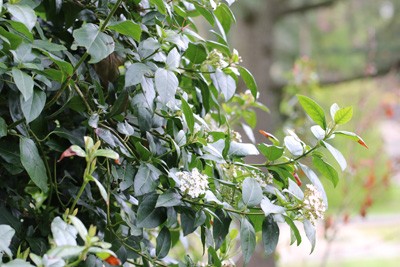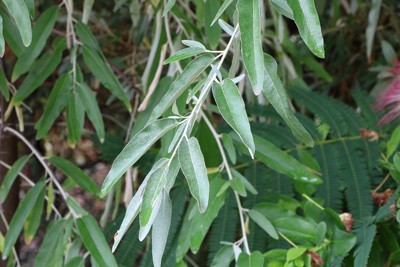They bring color and just structure to a garden, which is why dividing walls, whether high or low, the main thing evergreen, are also important. Thus, the garden is divided into sections and gets a structure. Topiary shrubs look very interesting, but they need pruning a few times a year. Shrubs usually get along with less care.
Contents
- 1 Popular woody plants
- 2 Kalmien
- 3 Pieris japonica
- 4 Viburnum tinus
- 5 White variegated scented flower (Osmanthus heterophyllus ‘Variegatus’)
- 6 Fruiting Shrub Pod (Ilex meserveae ‘Blue Princess’).
- 7 Variegated or variegated willow (Elaegnus pungens)
- 8 Variegated bay laurel (Leucothoe walteri)
- 9 Rhododendron fortunei, a wild species
- 10 Conclusion
- 11 Author
Popular woody plants
Evergreens look good through all seasons. Whether planted as a hedge or specimen, in small or larger groups, these woody plants do well in any garden.
I’ve gathered a selection here that I think would do well in my garden. I spare myself cypresses, false cypresses, trees of life and the like, enough has already been written about them. I’ll go with a few perhaps not yet popular evergreen shrubs.
Kalmien
Kalmien belong to the heather family. The plants are also called mountain laurel or laurel rose. The foliage is reminiscent of laurel, hence the name. The plants are quite undemanding. They require a moist, slightly acidic garden soil that should be well-drained. Waterlogging is not tolerated. The flowering time is around May to June. The plants grow 10 to 30 cm per year and reach an average height of 100 to 150 cm and a width of 70 to 120 cm. Now there are many varieties and every year there are more.
- Advantages: have many beautiful flowers, which look like stars. There are monochrome flowers and those with a different color border or dots. The foliage is also very decorative.
- Disadvantages: not all varieties are winter hardy, quite high purchase price, flowering period is short.
- Especially beautiful varieties:
- Olympic Wedding – white single flowers with pink small and large dots, richly blooming, blooms from mid-June, grows about 1 m tall and wide in 10 years
- Sterntaler – dark red single flowers with white edge and white patterns, grows very compact, blooms in June, grows 1.20 m tall and wide in 10 years
- Hania – white single flowers with pale pink banding, blooms in early to mid June, grows about 1 m in 10 years
Pieris japonica

This low-maintenance evergreen shrub is especially suitable for partial shade or even shade. There are many different varieties. Some score not only with their flowers, but also with a colorful leaf shoots. There are basically 10 species, but only two are interesting for the garden, Pieris japonica from Japan and Pieris floribunda from North America. In the Japanese species, the flower panicles overhang downward, and in the other they stand upright.
- Advantages: pruning is not necessary, most shade bells do not grow tall, grow slowly, beautiful flowers.
- Disadvantages: do not tolerate cold easterly winds, roots are sensitive to salt (fertilize carefully), are infested with web bugs, so a cool, shady location is important
- Beautiful varieties:
- Carnaval – white flowers and a fiery red leaf sprout, creamy white leaf margins on medium green leaves, hardy, blooms March/April, grows 10 to 30 inches a year and reaches 80 to 100 inches tall and 90 to 100 inches wide
- Valley Valentine – bright red flowers from mid-March to mid-April, strong green foliage, grows 5 to 15 cm a year and becomes 80 to 100 cm tall and much wider, well suited for planters
- Creamy white flowers in April/May, leaves brown-red when budding, later shiny green, grows up to 1.50 m tall and up to 130 cm wide, grows 10 to 20 cm a year
Viburnum tinus

This evergreen shrub is also called Mediterranean snowball, evergreen snowball or laurel snowball. The woody plant can grow up to 3.50 m high, but most usually manage only 2 m even in width. Especially interesting are the fragrant flowers that appear from November to April. Those who do not want to do without this plant, but live in the mountains, can cultivate it as a container plant. The winter it ideally spends in the winter garden, where it delights with its evergreen foliage.
- Advantage: beautiful flowers, can be cut well, best after flowering. Slow growing, most do not need much space.
- Disadvantage: only somewhat hardy, but thrives well in viticultural climates. Sensitive to drought and waterlogging, needs sheltered space
- Nice varieties:
- Little Bognor – blooms as early as August, quite hardy variety.
- Eve Price – numerous white to white-pink flower umbels. These can open as early as late autumn. Flowering up to 6 months, for sunny location, needs winter protection, growth height up to 150 cm.
- Eskimo – pure white spherical flower balls that give off a heavy fragrance. Blooms in April/May, does not grow tall, about 120 cm tall and 150 cm wide.
- In addition to bay-leaved snowball, there are more evergreen snowball varieties, such as evergreen scented snowball (Viburnum burkwoodii) and cushion snowball (Viburnum davidii). Most other snowball varieties are deciduous.
White variegated scented flower (Osmanthus heterophyllus ‘Variegatus’)

White variegated fragrant flower is an ilex-like, white variegated shrub with lovely fragrant flowers. The flowers are white and grow in clusters. The flowering period is from September to October. Foliage is white variegated, mostly green with white irregular margins and thorny. The plant is ideal for scented gardens or else for Japanese gardens. The location should be sunny to partial shade. The shrub grows about 60 to 100 cm tall, but I have also read that it can grow up to 250 cm tall. There are also other scented flowers, they differ from this one in foliage coloration and growth height. The white variegated scented flower is not yet so well known, practically still on the rise. So you can still score with it, if you have such a shrub in the garden.
- Advantages: the beguiling fragrance, beautiful foliage color, compact growth and not too high final size of the shrub.
- Disadvantages: rather high purchase price
Fruiting Shrub Pod (Ilex meserveae ‘Blue Princess’).
This eye-catching shrub, with its bright red fruiting ornament and shimmering blue foliage, is an eye-catcher in any garden. It is suitable as a specimen, but can also be used as a hedge plant, especially among other flowering shrubs with fruit ornaments or bird feeder shrubs. This holly grows upright and reaches a height of 100 to 150 cm. It is well suited for heather gardens and is an excellent bird nourishing shrub and also a bee pasture. The flowers are white and appear in May. The fruiting shrub pod is well tolerant of pruning. The fruits are bright red but unfortunately poisonous to humans.
- Advantages: very decorative, good for birds, also suitable for shade, ideal for roof gardens, absolutely frost hardy.
- Disadvantages: Berries poisonous, leaves thorny, or prickly.
Variegated or variegated willow (Elaegnus pungens)

Variegated olive willow is very popular for its green-yellow foliage. The leaves have an enormous luminosity. Most often the variety ‘Maculata’ is offered. This woody plant with its striking foliage reaches heights of up to 150 cm and also grows to about the same width. The flowers appear from October to November. They are creamy white, unfortunately somewhat inconspicuous and fragrant. The plant is enormously drought resistant. The location should be sunny to semi-shady and definitely protected from the wind. The variegated oil willow grows broadly bushy. It is ideal for sandy soils and also does well in planters. It is also suitable as a hedge plant. It is ideal to cover the root zone with a layer of foliage in winter.
- Advantages: very beautiful foliage, fragrant flowers, drought tolerant, high ornamental value.
- Disadvantages: not well tolerant of wind, not exactly inexpensive
Variegated bay laurel (Leucothoe walteri)
This dwarf to small shrub is a colorful splash of color in the garden. There are several varieties, but the plant is not yet very well known. There are varieties for sunny, but also for semi-shady to shady locations. The small plants bring new zest to monotonous heather gardens. The laurel pitcher thrives best near a pond.
Advantages: looks very good, grows quickly, good ground cover and beautifies dark corners in the garden, totally shade tolerant.
Disadvantages: not wind tolerant, so needs a wind protected location. Usually not salt tolerant, needs protection, not fully frost hardy everywhere.
Nice varieties:
- ‘Scarletta` – groundcover, fast growing, grows 40 cm tall but 100 cm wide, blooms in May/June, white, in clusters, leaf stems and new shoots red, not wind resistant
- ‘Rainbow’ – shade shrub, grows to 80 cm tall and 120 cm wide, fast growing, blooms in May/June, flowers white and in racemes, flowers fragrant, suitable for vase decorations, foliage green and red
Rhododendron fortunei, a wild species
I wanted to take not so common evergreen shrubs. Rhododendron does not fall into this category, but this one does. It is a special one. Rhododendron fortunei is a large shrub that grows about 3 to 5 meters high in our area. The flowers are white and have a slight scent of bubble gum. They appear in June. Probably, this rhododendron is the first hardy Chinese rhododendron introduced in our country.
Conclusion
There are a lot of evergreen shrubs. I haven’t even gone into many of them, such as yellow variegated aukube, the many barberry species, creeping spindle, shrub ivy, yellow mountain holly, shrub pod, golden privet, low mahonia, fruit myrtle, red glossy leaf, bay cherry, firethorn, flowering skimmia, and a few more. It is important that the site conditions are right. The soil can be suitably prepared, the location is predetermined. Watering, fertilizing, pruning, everything can be arranged appropriately, but if the place does not fit, the beautiful evergreen shrubs do not stand a chance. Sometimes they manage a few years, but then they are gone. So, choose well and do not go only by beauty!


